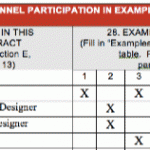
I enjoy the messages and questions that come across the LISTSERV of the Society of Marketing Professional Services. One person recently asked this question:
“Anyone willing to share information or provide a resource for information about copyright or use of image or articles (such as google, etc.)?”
This is typically a legal question. And while it would be great to get a lawyers perspective on this question, Scott Braley gave an experienced-based guideline on using photographs in your proposals and marketing materials. I kind of felt like his response should be archived somewhere.
Here is what he said:
“Hello:
To put my comments in perspective – 29+ years in AEC practice in multi-discipline firms, Managing Principal in international AE and CM/PM firm, 20 years as AEC consultant (overlapping – I’m not 101 years old). Worked with 325+ firms in consulting role …..
With that as background …
First and foremost – the key is honesty, good intention and limited/focused use of materials. Always give appropriate attribution to the source. No one is going to be put off or think less of you if you indicate the source of your photo material. Every (well, most) magazines attribute cover photo credits, photo credits in advertisements, etc. Simply do the same in your proposals. It is quite easy to add a line attributing photo credit.
The other important key is to check for limitations on use of the photos. We want people to respect our copyrights, let’s fully respect theirs.
Copyright – copyright all of your own work. Simply put the phrase “copyright _____ (year) by ____________________ (firm name). All rights reserved.” In this manner you have your intellectual and other property copyrighted. This is the speed bump for honest folk. If you have genuinely and highly valuable intellectual property, take a separate copyright action and register the product (costs legal fees in hundreds not thousands).
Others’ copyright – if others have copyrighted material you may have two options. One, if there is no prohibition on use, you can simply reference or use the material with their name and copyright noted. If there is a prohibition of use, you must contact them first and get permission to use.
Always confirm the permission in writing. Think about college papers, rules for use of copyrighted material apply in a similar manner.
Use of Photos and alternate sources – most architectural photography is copyrighted and use limited by the professional photographer. If no photographer is noted, you may wish to do a google image search to trace the photographer. Also there are many, many open source photo sources. Many have been identified in earlier correspondence on this smpslistserve so I will not repeat. In virtually all of these open source resources, you can get similar images that may be in the public domain and free of use limitations.
This is not go “go around” the copyright, rather to find an open source photo. For example if you need a photo of an interstate construction project, there are many that are open source public domain shots – you’ll have the same visual impact while honoring the copyright provisions of photographers, etc.
Use of clients’ materials – with few exceptions (e.g., DOD, NASA, FBI, State of ______) I have had no pushback from a client for using their logo or a project-related photo in a marketing proposal (this experience is from my practice days when I served in marketing lead roles). So long as the material (e.g., proposal) was for internal (i.e., only to the client) purposes, they did not mind that we used their photo images to let them know that we had visited their site, knew of their “phase one” work on a project, etc.
Finally, I am not an attorney nor do we represent ourselves as giving legal advice or counsel. So, all of the above is simply sharing experiences.”
Keep in mind, Scott’s response is an experience-based editorial comment. Recommendations vary based on each firm’s/individual’s situation.
Scott Braley is the principal consultant with 30-years experience in private A/E/C practice with multi-discipline firms. He served as Managing Principal in an international A/E and CM/PM firm that ranked in the ENR “Top 20” and the World Architecture “Top 40.” His firm, Braley Consulting & Training, is an Atlanta-based full-service practice providing consulting, training, facilitation, assessment and coaching services for A/E/C industry firms. You can contact him at [email protected] or at 404-252-9840.





Matt, I’ve seen this post pop up on social media before, and thought I’d add my two cents. I’ve had about 1500 photos published over the years – many in my own books, but also in visitors guides, relocation guides, magazines, etc. Beyond that, I’ve posted many of my photos online. And my copyrights have been violated many, many times. People don’t mean to “steal” – they just don’t understand intellectual property laws.
If you find a photo of mine online and use it on our proposal, you’ve violated my copyright. (You lawbreaker!) Copyright law protects original works from the moment they are created. So if you write something original, you own the copyright to it. (Unless you do it at work – than it may be considered ‘work for hire,’ but let’s save that for another post.)
If a reader likes your blog post, and publishes it elsewhere without your permission, they have violated your copyright. There are some provisions that allow for limited quotation. With visual works, like photos and paintings, you cannot reproduce them without the creator’s permission. An argument can be made for using them in an educational presentation under the “fair use” provisions, but if you are a for-profit corporation, tread lightly.
Don’t use any photos that you’ve found on the Web unless you have WRITTEN PERMISSION from the copyright owner. And remember, no copyright symbol is required, and the word “copyright” is not required, either. Every photograph is copyrighted. Those thousands of photos you have on your phone? You own the copyrights to all of those. However, in order to prove infringement, you should have the photo registered (but this is not a requirement for copyright).
If you are going to use a photo you found online, make sure it has a Creative Commons license. You’ll usually need to credit the copyright owner, but you can otherwise use it as you please. In Google Images, you can filter images by those whose copyright holders have licensed them for reuse. Wikimedia Commons has lots of photos. There are also some stock galleries that allow you to use their photos for free – or you can use a stock gallery like Adobe and license the image. Happy to chat further.
Scott,
Thank you for weighing in on this topic.
I’ve been absolutely astounded in the industry that people think they can use whatever they find on Google “because it’s on the internet so it must be free”…. yes to using Creative Commons photos or better yet, reaching out and asking permission to use photos from other firms. Even better, make a point to have your own staff take photos of your projects, and hire a professional photographer. I’ve also seen discussions with legal where they tell PMs not to use those types of photos, but it’s such a difficult thing to control with hundreds or thousands of employees. If you have photos that your firm owns, that seems to be the best way to counteract it.